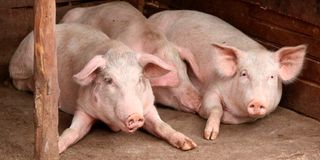Premium
How to protect pigs from deadly diseases

Pigs at Ms Fracia Thogori's farm in Kiambu on July 11, 2022.
Pig farming in Kenya has stagnated mainly due to the high cost of feeds and the dreaded African swine fever (ASF) disease. According to Statista, a reputable global statistics firm, Kenya was estimated to have a national population of about 700,000 thousand pigs in 2021; almost doubling in 12 years from about 400,000 in the 2009 census.
The increase may appear large but it is only about 6.3 per cent annually within the 12-year period. It also translates to about one pig for every 72 Kenyans. The pig population should ideally increase faster to help meet the rising demand.
ASF is a deadly disease of pigs that is ever present in the country. Its occurrence has increased due to slackened enforcement of pig production regulations. It is common nowadays to see pigs being reared in the open while pig production regulations require the animals to be reared in confinement, on paved floors, to prevent infection with ASF and infestation with the pig tapeworm.
The worm is not only bad for pigs but is also a serious public health risk. Some immature stages of the parasite get into the muscles of pigs. Humans eat them when they consume affected pork raw or inadequately cooked. The worm may get into the spinal cord or the brain to cause a condition known as neurocysticercosis. Such patients get seizures, headaches, psychiatric disturbances, difficulty with balance, and finally death.
Consumers are advised to avoid eating pork from pigs that are reared in open pastures or environments. During the course of my practice, I have encountered people who have argued that rearing pigs in confinement is an unnecessary cost burden to pig farmers.
My response has always been that while people are free to use the most cost-effective method to earn their livelihoods, they should not put the lives of others at risks that are already known and have effective mitigation measures.
ASF has been in Kenya for the past 113 years. It was first described in 1921in The Journal of Comparative Pathology and Therapeutics where it was reported to have occurred as early as 1910. The disease was, however, kept under control through confined pig rearing until the 1990s when there was a major outbreak.
There have been periodic outbreaks since the 90s. Farmers have kept losing their herds frequently. Those outbreaks have highly discouraged new farmers from venturing into pig farming while existing ones hesitate to expand.
ASF wipes out almost all the pigs in affected herds and has no cure or vaccine. Affected farms are required to kill all the pigs and dispose of the carcasses by burning or deep burial. Unfortunately, the Kenya government has no compensation provision for affected farms.
A light in prevention of the disease has been shining ever brighter for the past three years. The United States, Vietnam, Britain, Thailand and The Phillipines have all announced the development of viable vaccine candidates.
Vietnam, Thailand and The Phillipines are in the advanced stages of commercialising vaccines that have proved effective in preventing ASF infection in controlled trials.
Two other diseases are contributing to stagnation of pig farming in Kenya. Porcine parvovirus (PPV) is a fairly new disease to Kenyan farmers. Of late, I have increasingly seen suspected cases of the disease rise on farms.
PPV rarely kills the adult pigs but is a heavy reproductive setback. It causes repeat breeding, death of foetuses in the uterus resulting in delivery of mummies at term, production of stillbirths and weak piglets that die by the 14-16th day of life.
The disease is transmitted through semen, contact and discharges including faeces. The virus can stay in the environment for up to four months. There is no treatment for the disease but can be prevented through vaccination of breeding stock two weeks before insemination and two weeks before farrowing.
PPV cripples pig farming by disrupting breeding, reproduction and production. I visited a farm this week in Murang’a because the farmer had suddenly experienced repeat breeding of his pigs, infection of the uterus and farrowing of small number of piglets per sow. Other sows gave birth to dead foetuses, weak piglets and apparently healthy piglets that died by the 16th day of life.
Some of the piglets on the farm also had painful swollen joints from the shoulder to the hooves,, convulsions and disorientation. This is the third disease causing stagnation of pig farming. Incidentally, it was my first time to see it occurring concurrently with PPV on the same farm.
The disease is bacterial, caused by Escherichia coli. In many cases, some of the bacteria produce toxins and cause a variant disease form called gut oedema. Piglets treated early in the disease may recover but those that show nervous signs such as trembling and disorientation usually die. Some survivors fail to thrive and never reach mature weight. Gut oedema/joint ill can be prevented through vaccination of breeders before and during pregnancy.
I diagnosed the problem on Kimani’s farm to be joint ill/gut oedema and PPV based on the presentation of the diseases and my postmortem examination of some stillborn piglets. I could not take samples for laboratory analysis of PPV because the test is currently not available in the country.
I advised on refining the farmer’s vaccination, disease detection and hygiene programmes to effectively control the diseases.





